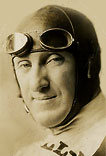 E.G. Baker was an early motorcycling pioneer who set dozens of cross-country records riding a variety of motorcycles and sidecars. He also was known for record-setting runs in automobiles. By the time he retired from his pursuit of records, it was estimated that Baker had ridden or driven more than five million miles. During his exhausting career, Baker made more than 143 attempts at a variety of timed, long-distance records, including his most famous transcontinental and three flags (Canada to Mexico) attempts.
E.G. Baker was an early motorcycling pioneer who set dozens of cross-country records riding a variety of motorcycles and sidecars. He also was known for record-setting runs in automobiles. By the time he retired from his pursuit of records, it was estimated that Baker had ridden or driven more than five million miles. During his exhausting career, Baker made more than 143 attempts at a variety of timed, long-distance records, including his most famous transcontinental and three flags (Canada to Mexico) attempts.
Born Erwin George Baker in 1882 in a four-room log house in Dearborn County, Indiana, Baker moved to Indianapolis when he was 12 years old. Baker learned the machinist trade and worked in a foundry. A tall and lanky youngster, Baker became interested in athletics and participated in boxing, wrestling and tumbling. He worked out in a gymnasium faithfully and gained a reputation as quite an athlete. His athleticism earned him a job with a acrobatic drill team that traveled the vaudeville circuit at the turn of the century. Erwin was also part of the popular bicycle racing craze at the time, which led to him riding some of the first motorized bicycles.
In 1908, Baker purchased an Indian motorcycle and began entering and winning local races. His most famous victory came in 1909 at the first race ever held at the newly built Indianapolis Motor Speedway. It was during this time that Baker began his endurance runs. Most of his early records were city-to-city runs. One of Baker's well-publicized stunts was racing passenger trains from town to town. These were in the days before well-maintained roads. Baker often encountered deep mud, sand washes, flooded river crossings and snowed-in mountain passes during his long-distance attempts.
Baker's big break came in 1912 when Indian's George Hendee commissioned Baker to take a two-speed, seven-horsepower model on a demonstration tour of Cuba and Central America. Baker would be closely associated with Indian for the rest of his motorcycle endurance career, although he was independent and also undertook record rides for other motorcycle makers. In 1913, Baker rode an Indian on a record transcontinental run which ended in Savannah, Georgia. Once there, he entered the 300-mile national championship on the same machine he had just ridden across the country.
After a record-setting transcontinental run in by Baker in 1914, a New York newspaper writer compared him to the Cannonball Express train and he picked up the famous moniker that would stick with him the rest of his life.
Baker accumulated his share of scars as well as trophies during his years of setting records. He also had a slew of interesting stories of things that happened to him during his record runs. In one three-flags record attempt in 1916, Baker had to change routes several times to avoid vast forest fires. In another run he came around a curve at a high rate of speed and came upon a herd of cattle in the road. In trying to miss the herd, Baker turned sharply, hit a hole in the road and was thrown off his motorcycle into a fence which in turn bounced him right onto the back of one of the cows. The surprised cow bucked him off and he ultimately landed in a ditch off the side of the road.
Baker took his skills overseas and set numerous records in foreign countries, most notably Australia and New Zealand.
By the 1930s, Baker began shifting his focus and most of his record attempts were in automobiles. In 1922, he ran in the Indianapolis 500 and finished 11th, though well back of the leaders. He also became a test driver for automobile companies. He worked for Rickenbacker Automobiles, which was owned by the famous World War I flying ace Eddie Rickenbacker. On motorcycles, Baker began increasingly to participate in economy runs. In one such run, his Neracar motorcycle went 3,364 miles on 45 gallons of gas. He became an AMA race official and later was named national commissioner for NASCAR. After his record-setting days Baker also took up building miniature racing cars.
Baker died in Indianapolis on May 10, 1960, survived by his wife Emma. Baker goes down in history as one of the most famous motorcyclists of the early 20th century. His name was perhaps the most recognized of any motorcycle racer through the 1930s.